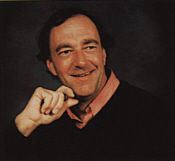
Robert Taylor Biography
The name Robert Taylor has been synonymous with aviation art over a quarter of a century. His paintings of aircraft, more than those of any other artist, have helped popularise a genre which at the start of this remarkable artist's career had little recognition in the world of fine art. When he burst upon the scene in the mid-1970s his vibrant, expansive approach to the subject was a revelation. His paintings immediately caught the imagination of enthusiasts and collectors alike . He became an instant success.
As a boy, Robert seemed always to have a pencil in his hand. Aware of his natural gift from an early age, he never considered a career beyond art, and with unwavering focus, set out to achieve his goal. Leaving school at fifteen, he has never worked outside the world of art. After two years at the Bath School of Art he landed a job as an apprentice picture framer with an art gallery in Bath, the city where Robert has lived and worked all his life. Already competent with water-colours the young apprentice took every opportunity to study the works of other artists and, after trying his hand at oils, quickly determined he could paint to the same standard as much of the art it was his job to frame.
Soon the gallery was selling his paintings, and the owner, recognising Robert's talent, promoted him to the busy picture-restoring department. Here, he repaired and restored all manner of paintings and drawings, the expertise he developed becoming the foundation of his career as a professional artist. Picture restoration is an exacting skill, requiring the ability to emulate the techniques of other painters so as to render the damaged area of the work undetectable. After a decade of diligent application, Robert became one of the most capable picture restorers outside London. Today he attributes his versatility to the years he spent painstakingly working on the paintings of others artists.
After fifteen years at the gallery, by chance he was introduced to Pat Barnard, whose military publishing business happened also to be located in the city of Bath. When offered the chance to become a full-time painter, Robert leapt at the opportunity. Within a few months of becoming a professional artist, he saw his first works in print. The Military Gallery has published every print reproduced from Robert's paintings ever since.
Robert's early career was devoted to maritime paintings, and he achieved early success with his prints of naval subjects, one of his admirers being Lord Louis Mountbatten. He exhibited successfully at the Royal Society of Marine Artists in London and soon his popularity attracted the attention of the media. Following a major feature on his work in a leading national daily newspaper he was invited to appear in a BBC Television programme. This led to a string of commissions for the Fleet Air Arm Museum who, understandably, wanted aircraft in their maritime paintings. It was the start of Robert's career as an aviation artist.
Fascinated since childhood by the big, powerful machines that man has invented, switching from one type of 'hardware' to another has never troubled him. Being an artist of the 'old school', Robert tackled the subject of painting aircraft with the same gusto as with his large, action-packed maritime pictures - big compositions supported by powerful and dramatic skies, painted on large canvases. It was a formula new to the aviation art genre, at the time not used to such sweeping canvases, but one that came naturally to an artist whose approach appeared to have origins in an earlier classical period.
Robert's aviation paintings are instantly recognisable. He somehow manages to convey all the technical detail of aviation in a traditional and painterly style, reminiscent of the Old Masters. With uncanny ability, he is able to recreate scenes from the past with a carefully rehearsed realism that few other artists ever manage to achieve. This is partly due to his prodigious research but also his attention to detail: Not for him shiny new factory-fresh aircraft looking like museum specimens. His trade mark, flying machines that are battle-scarred, worse for wear, with dings down the fuselage, chips and dents along the leading edges of wings, oil stains trailing from engine cowlings, paintwork faded with dust and grime; his planes are real!
Robert's aviation works have drawn crowds in the international arena since the early 1980s. He has exhibited throughout the US and Canada, Australia, Japan and in Europe. His one-man exhibition at the Smithsonian's National Air and Space Museum in Washington DC was hailed as the most popular art exhibition ever held there. His paintings hang in many of the world's great aviation museums, adorn boardrooms, offices and homes, and his limited edition prints are avidly collected all around the world.
A family man with strong Christian values, Robert devotes most of what little spare time he has to his home life. Married to Mary for thirty five years, they have five children, all now grown up. Neither fame nor fortune has turned his head. He is the same easy-going, gentle character he was when setting out on his painting career all those years ago, but now with a confidence that comes with the knowledge that he has mastered his profession



